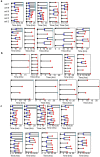SHR and SCR coordinate root patterning and growth early in the cell cycle
- PMID: 38297119
- PMCID: PMC10866714
- DOI: 10.1038/s41586-023-06971-z
SHR and SCR coordinate root patterning and growth early in the cell cycle
Abstract
Precise control of cell division is essential for proper patterning and growth during the development of multicellular organisms. Coordination of formative divisions that generate new tissue patterns with proliferative divisions that promote growth is poorly understood. SHORTROOT (SHR) and SCARECROW (SCR) are transcription factors that are required for formative divisions in the stem cell niche of Arabidopsis roots1,2. Here we show that levels of SHR and SCR early in the cell cycle determine the orientation of the division plane, resulting in either formative or proliferative cell division. We used 4D quantitative, long-term and frequent (every 15 min for up to 48 h) light sheet and confocal microscopy to probe the dynamics of SHR and SCR in tandem within single cells of living roots. Directly controlling their dynamics with an SHR induction system enabled us to challenge an existing bistable model3 of the SHR-SCR gene-regulatory network and to identify key features that are essential for rescue of formative divisions in shr mutants. SHR and SCR kinetics do not align with the expected behaviour of a bistable system, and only low transient levels, present early in the cell cycle, are required for formative divisions. These results reveal an uncharacterized mechanism by which developmental regulators directly coordinate patterning and growth.
© 2024. The Author(s).
Conflict of interest statement
P.N.B. was the co-founder and Chair of the Scientific Advisory Board of Hi Fidelity Genetics, Inc, a company that works on crop root growth. The other authors declare no competing interests.
Figures












References
-
- Scheres B, et al. Mutations affecting the radial organisation of the Arabidopsis root display specific defects throughout the embryonic axis. Development. 1995;121:53–62. doi: 10.1242/dev.121.1.53. - DOI
MeSH terms
Substances
Grants and funding
LinkOut - more resources
Full Text Sources

